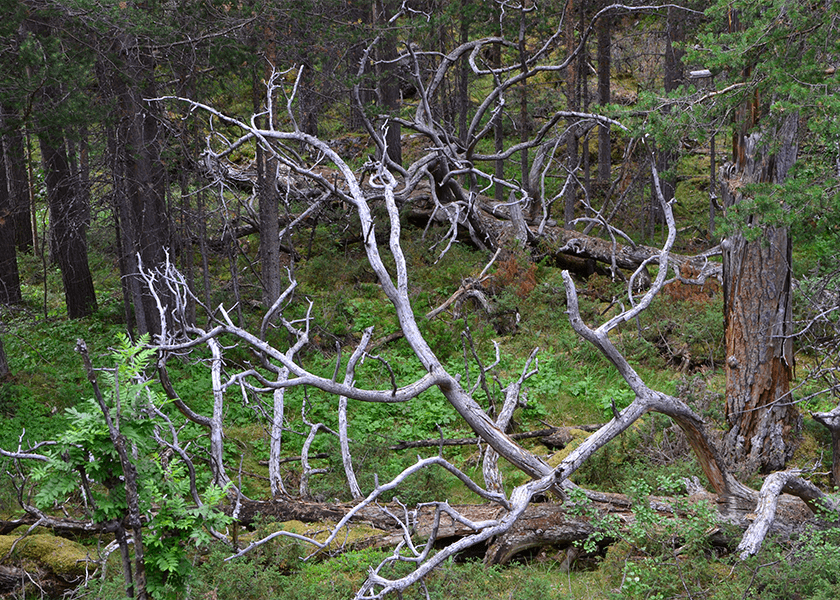
The fly specimen that awaited a growing barcode community to be dusted off the shelves and given a name
The fly specimen that awaited a growing barcode community to be dusted off the shelves and given a name
Reisa National Park, Norway. The type locality of a new fungus gnat species Coelosynapha loici.
PHOTO CREDIT: J. Kjærandsen
While it can take an average of 21 years between the discovery and description of a new species1, the challenges of relating known taxa and the scarcity of high-quality specimens make the description of a new genus even more difficult and time-consuming. Our paper recently published in the Biodiversity Data Journal introduced a new fungus gnat genus–Coelosynapha–demonstrating that despite a taxon being shelved for a long time after discovery, strong collaborative networks spanning many countries combined with the power of DNA barcoding are greatly changing the pace at which we catalogue life.
This story begins some 25 years ago when the late French entomologist Loïc Matile (1938–2000) sent Geir E.E. Søli (at the Natural History Museum in Oslo, Norway) illustrations and a brief one-page description of a potential new fly genus, belonging to fungus gnats of the family Mycetophilidae, based on a single specimen collected in Finland. Matile posed a seeming simple question to Søli, “Had this for years…What do you think?” Unable to do much with the scarce material, the specimen was shelved, twice, for even after more specimens were found in Finland in 2009 and sent to a specialist in the USA, no progress was made.
Growth of research ties and a reference library
During this time, the popular and widespread use of DNA barcoding has led to an accumulation of a substantial volume of sequenced insects on the Barcode of Life Data (BOLD) system. More than 65,000 specimens belonging to the fly family Mycetophilidae have been successfully sequenced. Some 1,100 of them have public barcodes, although more than 2,400 different Barcode Index Numbers (BINs) are assigned, which indicates that the majority of the species still remain unidentified beyond the (sub)family level.
In the Nordic region, strong scientific research ties grew during the early 2000s between the Swedish, Norwegian, and Finnish biodiversity information centres, taxonomy initiatives, and the Norwegian Barcode of Life (NorBOL) and Finnish Barcode of Life (FinBOL). These alliances are ensuring that the best taxonomic expertise is building up data in the reference library for local fauna on BOLD. Hence, the vast majority of some 6,500 DNA barcoded fungus gnats from the Nordic region have been identified to species level upon submission. The reference library is then painstakingly quality-checked and curated after barcodes and BINs are assigned. This has resulted in a high-quality reference library, now covering about 90 percent of up to 1,000 known Nordic species of the family.
The reference library gives us entirely new opportunities through machine identification of insect samples. Examples range from expanded taxonomic studies on the larger Holarctic fauna as in this study, to ecological studies on how fungus gnats function in our boreal ecosystems, to more applied stakeholder science ranging from management of unprotected and protected areas to monitoring insect populations and the often claimed decrease in insect diversity caused by disturbances like commercial land use, pesticides from agriculture, and climate change.


Holotype of Coelosynapha loici sp. n. (left) and Coelosynapha heberti sp. n. (right).
PHOTO CREDIT: J. Kjærandsen (left) & CBG Photography Group (right)
A new genus is born from treasures on BOLD
Continuing the exploration of fungus gnats, we obtained more specimens of the enigmatic new species first studied by Matile way back in the mid-1980s from several, mainly old-growth, coniferous sites across the Palaearctic Taiga; ranging from Norway in the west all the way to Chukotka in the Far East of Russia. Specimens of the new taxon from Russia and Fennoscandia (a region covering the Scandinavian Peninsula, Finland, Karelia, and the Kola Peninsula) were submitted for barcoding. We were surprised to find that the BINs assigned on BOLD indicated these specimens were the nearest neighbour to another unidentified, and very similar species sampled across southern Canada between 2004–2014 during the Centre for Biodiversity Genomics’ early efforts to barcode the insects of Canada2
Both species were assigned to a new genus named Coelosynapha. The first, Eurasian Coelosynapha loici, is named in honour of Loïc Matile. The second, North American Coelosynapha heberti, is named in honour of Paul D. N. Hebert, “the father” of DNA barcoding who led efforts to barcode the insects of Canada and currently leads the International Barcode of Life (iBOL) as the organization’s scientific director. Taken together it marks a celebration of the synergy emerging from traditional morphologically based taxonomy meeting a new integrative taxonomy including DNA barcodes in its toolbox.
The newly described genus belongs to the subfamily Gnoristinae which appears to be amongst the most difficult branches of the Mycetophilidae to classify, which certainly added to the prolonged shelf life.
It marks a celebration of the synergy emerging from traditional morphologically based taxonomy meeting a new integrative taxonomy including DNA barcodes in its toolbox.
Highly variable taxa have led to numerous small genera with few species being segregated, as well as species-rich, polyphyletic genera sometimes called “trash bin” genera because they are derived from more than one common evolutionary ancestor or ancestral group and are therefore not suitable to be placed in the same taxon.
Morphologically Coelosynapha is most similar to the genera Coelosia and Synapha, hence its name, while genetically, species of these genera appear rather distant. As the new species epithets suggest, there is a need for more integrative taxonomic studies combining classical morphology with DNA barcoding.
The BOLD archive certainly hides many similar treasures waiting to be uncovered, but for that to happen morphological expertise needs to be invoked. Through our description of Coelosynapha, we hope to inspire this kind of integrative taxonomic work on the species-rich family of fungus gnats and aspire to further phylogenetic studies of the intriguing subfamily Gnoristinae.
References:
1. Fontaine B, Perrard A, Bouchet P (2012) 21 years of shelf life between discovery and description of new species. Current Biology 22 (22). doi: 10.1016/j.cub.2012.10.029
2. Hebert PN, Ratnasingham S, Zakharov E, Telfer A, Levesque-Beaudin V, Milton M, Pedersen S, Jannetta P, deWaard J (2016) Counting animal species with DNA barcodes: Canadian insects. Philosophical Transactions of the Royal Society B: Biological Sciences 371 (1702). doi: 10.1098/rstb.2015.0333
Written by

Tromsø University Museum, UiT – The Arctic University of Norway Tromsø, Norway

Alexei Polevoi
Forest Research Institute of Karelian Research Centre of the Russian Academy of Sciences Petrozavodsk, Russia

Jukka Salmela
doi: 10.21083/ibol.v10i1.6401
Don't Miss Out!
Subscribe to the iBOL Barcode Bulletin for updates on DNA barcoding efforts, the iBOL Consortium, and more.
comment on this article
The Barcode Bulletin moderates comments to promote an informed and courteous conversation. Abusive, profane, self-promotional, or incoherent comments will be rejected.

